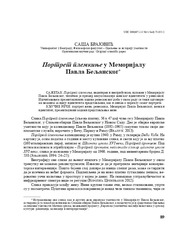Prikaz osnovnih podataka o dokumentu
Portret plemkinje u Memorijalu Pavla Beljanskog
Portrait of a Noble Woman in the memorial of Pavle Beljanski
| dc.creator | Brajović, Saša | |
| dc.date.accessioned | 2021-10-12T11:49:57Z | |
| dc.date.available | 2021-10-12T11:49:57Z | |
| dc.date.issued | 2013 | |
| dc.identifier.issn | 0352-6844 | |
| dc.identifier.uri | http://reff.f.bg.ac.rs/handle/123456789/1700 | |
| dc.description.abstract | Portret plemkinje, nedatiran i neatribuisan, izložen u Memorijalu Pavla Beljanskog, tipičan je primer vizualizacije ženskog identiteta u renesansi. Iščitavanjem prezentacionih kodova renesansnog doba u ovom radu se teži odgovorima vezanim za ideju identiteta predstavljene, kao i onima o poreklu samog portreta. | sr |
| dc.description.abstract | The painting Portrait of a Noble Woman (oil on canvas, 56 x 47 cm) is on display in the Memorial Collection of Pavle Beljanski since 1966 as part of the Memorial dedicated to this important collector who, besides part of the Serbian art, collected many paintings of European new age art. The painting is undated and unattributed. Beljanski bought it in Rome in 1949 as a Portrait of a Princess and a piece by 'an unknown author of the Spanish school from the 16th century.' The elements of the painting shape the contours of the identity of an unknown woman, which is reconstructed in an interpretative procedure that includes the analysis of the social and cultural context, as well as the gender construction of the personality. The manner in which the face of the woman is constructed and placed suggests that she projects the aesthetic, ethical and social ideals of the Renaissance, most likely of the second half of the 16th century. Her hair, clothes and especially jewelry indicate the status of a married woman from aristocracy. The jewelry, which is visually the most dominant element of the painting, implies not only the high social status, but also a probable north Italian, most likely Venetian origin of the painting. The 'Spanish' identity emphasized in Beljanski's note has a special place in the construction of the presentation of the noble woman. It indicates the articulation of the Renaissance female identity with clothes, accessories and behavioral techniques similar to the ones in the Spanish court. The Renaissance politics of gender roles demanded the reconstruction of the woman's face that visually precisely demonstrates what the society expects of her. In that sense the woman from the painting in the Memorial fully embodies the presupposed idea of the female Renaissance identity. At the same time, the calm gaze directed at the observer expresses the emphasizes personality which Renaissance bestowed upon female portraits. | en |
| dc.publisher | Matica srpska, Novi Sad | |
| dc.rights | openAccess | |
| dc.source | Zbornik Matice srpske za likovne umetnosti | |
| dc.subject | ženski identitet | sr |
| dc.subject | renesansa | sr |
| dc.subject | prezentacioni kodovi predstavljanja žene | sr |
| dc.subject | portret žene | sr |
| dc.subject | Memorijal Pavla Beljanskog | sr |
| dc.title | Portret plemkinje u Memorijalu Pavla Beljanskog | sr |
| dc.title | Portrait of a Noble Woman in the memorial of Pavle Beljanski | en |
| dc.type | article | |
| dc.rights.license | ARR | |
| dc.citation.epage | 94 | |
| dc.citation.issue | 41 | |
| dc.citation.other | (41): 89-94 | |
| dc.citation.rank | M51 | |
| dc.citation.spage | 89 | |
| dc.identifier.fulltext | http://reff.f.bg.ac.rs/bitstream/id/589/1697.pdf | |
| dc.identifier.rcub | https://hdl.handle.net/21.15107/rcub_reff_1700 | |
| dc.type.version | publishedVersion |

